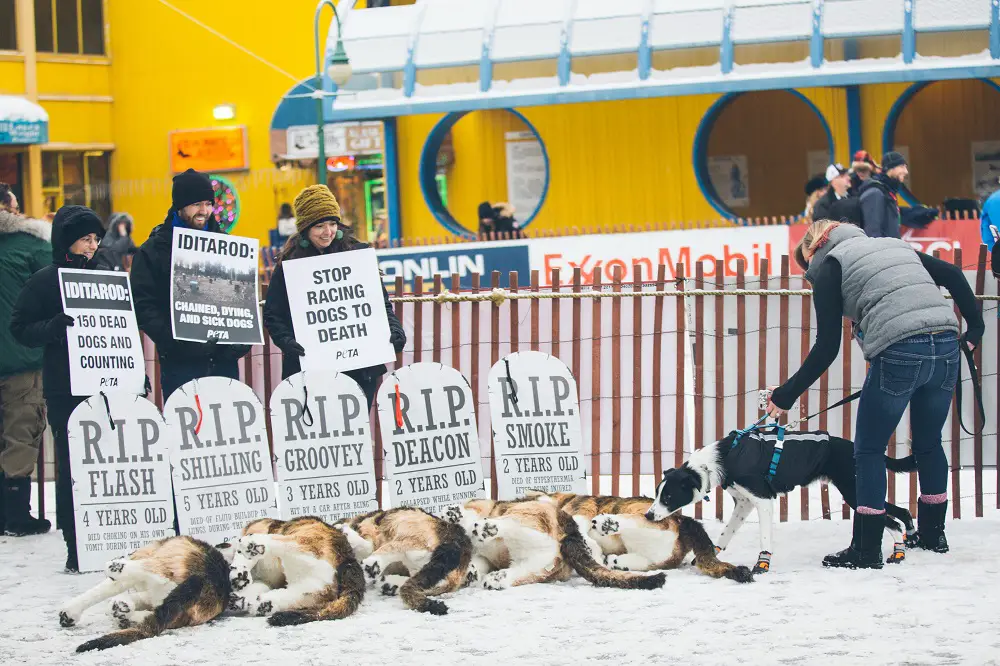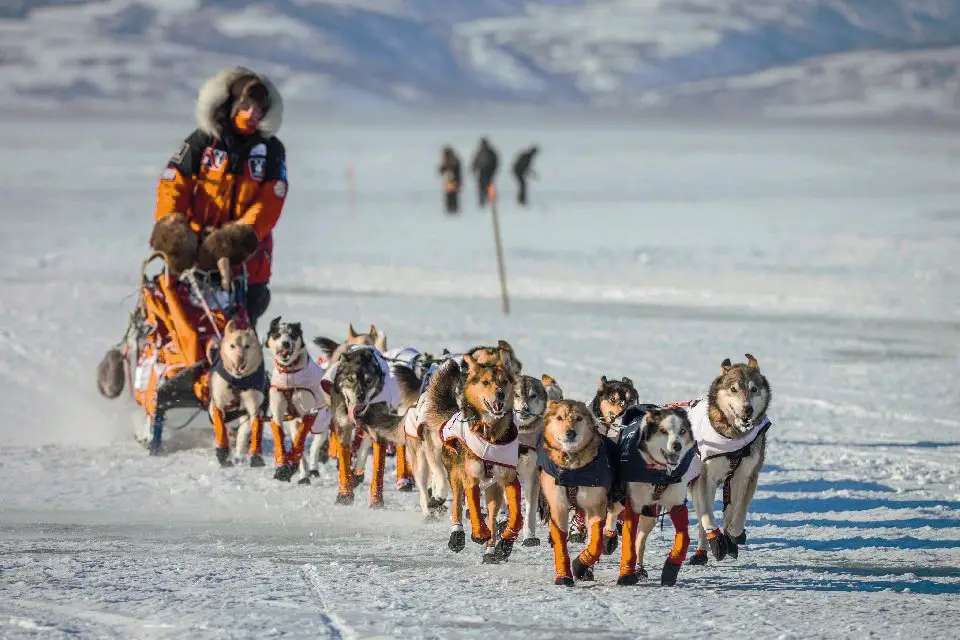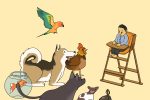The Iditarod, a nearly 1,000-mile race from Anchorage to Nome through icy winter weather, concluded in March 2018. The race traces an old dog sled freight trail that American settlers used before Alaska became a state.
The dog teams that race in late wintertime take the place of the winter Olympians, and they’re much cuter and fuzzier. These dogs are athletes that train all year with their owners: if you float down the Chena River in the muddy heat of July, you still might catch a dog team barking excitedly as they tug their owner along the bank in an ATV.
The mushers love their dogs but they also push them to perform in the same way parents are dedicated to their kids’s success in sports such as skiing, skateboarding or ice dancing. Some animal rights groups, such as People for the Ethical Treatment of Animals (PETA), or fans of the documentary “Sled Dogs” would say that the push is too much and that it crosses the boundary into unacceptable abuse.
“Sled Dogs” and PETA
Fern Levitt released the documentary “Sled Dogs” in the United States in 2017. The documentary scathingly critiques dog mushing as animal abuse, especially the Alaskan Iditarod.
The film shows scenes of dogs racing as well as being chained to posts, a common practice for handlers with dozens of animals, but they also show graphic images of the brutal sides of the business.
Mushers, including those featured in the film, have denounced it as untruthful, claiming that the documentary unethically focused on the one or two bad handlers, but animal rights organizations have latched onto the film, especially the deaths caused by overexertion or culling.
This year, PETA protested the dog sled race, collaborating with local animal rights activists to shock the viewing public into addressing the issue. In their press release on Feb. 27, they described the time, date and location of their event, as well as a picture of what would take place.
“Dressed in black, a group of PETA supporters will gather around five headstones — engraved with the name, age, and cause of death of each dog who died during the 2017 Iditarod — outside of the 2018 Iditarod Ceremonial Start, with a second protest to follow outside the race’s Willow restart,” announced PETA.
Levitt, a Canadian, joined the protesters in Anchorage, who protested as a reaction to the death of five dogs as a result of last year’s Iditarod (the most to die in the event since 2009) and the dog doping scandals over the past several years.
However, PETA didn’t meet a welcoming crowd, perhaps because the majority of the small group flew in from out of state to protest. A local fur trader, Richard Zeigler, stood beside the protesters, wearing a bear pelt and distributing promotional material for the Alaska Fur Gallery.
Deaths and Doping
PETA and Levitt’s concerns are not baseless: this year’s Iditarod yet again hosted the heartbreaking and controversial event. Last year, five dogs died, and the Iditarod Trail Committee (ITC) accused Dallas Seavey of doping his team. This year, one dog, Blondie, died on the trail, and accusations of using performance-enhancing drugs in dogs dominated the news.
When dogs get too ill to continue, a musher usually elects to drop them at a checkpoint along the race. Musher Katherine Keith dropped the struggling Blondie at the Koyuk checkpoint, and bad weather prevented vehicles from transporting the five-year-old male to better veterinary services.
The diagnosis of aspiration pneumonia was all too familiar to his handler; last year, another of Keith’s dogs, Flash, died of the same condition just before that checkpoint. Flash’s name appeared on the mock gravestone of the PETA protesters beside the other four dogs’: Smoke (hyperthermia), Groovey (car accident), Shilling (unknown) and Deacon (unknown).

This year’s doping scandal builds upon the old outrage toward Iditarod controversies. Deacon, one of the five dogs that died last year, belonged to Seavey, whom the ITC accused of doping his dogs with banned performance-enhancing drugs during the same 2017 race.
This year, musher Wade Marrs accused the chief of the ITC drug testing program, Dr. Morrie Craig, of threatening to expose him for doping his dogs that year. Marrs claims that Craig tried to scare him out of supporting his fellow musher, Seavey, in his personal doping legal battle. Craig expresses regret for what he describes as a simple misunderstanding.
What the Mushers Say
Regardless of these tragedies and ethical dilemmas, most of the human participants of the Iditarod love their dogs and see them as family, just like any other pet owner. Friends note the close relationship between Keith and Blondie, saying he was her favorite dog and that they were very close.
This year’s winner, Joar Leifseth, describes the evolution of his relationship with dogs throughout his life. “This dream of having a dog team has been with me since I was a little kid… Once I moved out… I had four dogs on my own… Obviously, I like dogs, and I like nature,” said Leifseth.
The fastest ever female musher, Aliy Zirkle, also feels deeply connected to her dogs. Although she only placed 15th out of 60 mushers this year, Zirkle has won second place three times and finished in the top 10 six times. Her connection with her dogs is similar to that among athletes on a team.
Zirkle noted that one of the dogs strongly resembled her. Dutch, as she described, “is an incredibly hard worker, enthusiastic now-and-then, a social dog, he likes to take his rest but knows when rest is over, it’s time to go… and he’d like to win the Iditarod 2018!”
The Alaskan Iditarod has its controversies, but it also has passionate mushers and a worldwide audience. Organizations such as the ITC do their best to ensure the safety of all participants, both human and furry contestants; however, like in any sport, some slip through the cracks. As for the fundamental ethics of dog mushing, PETA, Iditarod mushers, “Sled Dogs” and the people of Anchorage continue to disagree.
















